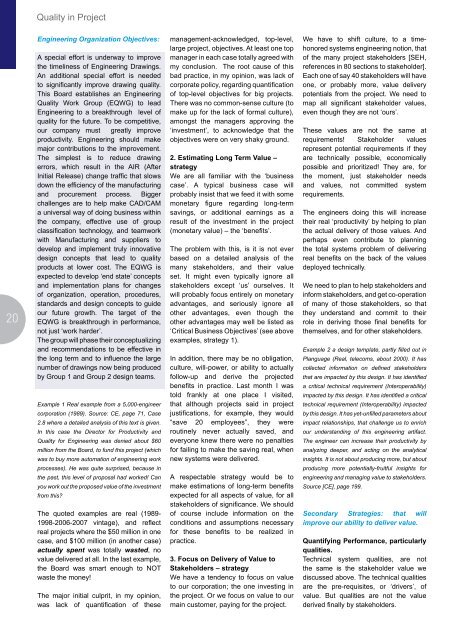Comparison of Change Management Systems
Comparison of Change Management Systems
Comparison of Change Management Systems
Create successful ePaper yourself
Turn your PDF publications into a flip-book with our unique Google optimized e-Paper software.
20<br />
Quality in Project<br />
Engineering Organization Objectives:<br />
A special effort is underway to improve<br />
the timeliness <strong>of</strong> Engineering Drawings.<br />
An additional special effort is needed<br />
to significantly improve drawing quality.<br />
This Board establishes an Engineering<br />
Quality Work Group (EQWG) to lead<br />
Engineering to a breakthrough level <strong>of</strong><br />
quality for the future. To be competitive,<br />
our company must greatly improve<br />
productivity. Engineering should make<br />
major contributions to the improvement.<br />
The simplest is to reduce drawing<br />
errors, which result in the AIR (After<br />
Initial Release) change traffic that slows<br />
down the efficiency <strong>of</strong> the manufacturing<br />
and procurement process. Bigger<br />
challenges are to help make CAD/CAM<br />
a universal way <strong>of</strong> doing business within<br />
the company, effective use <strong>of</strong> group<br />
classification technology, and teamwork<br />
with Manufacturing and suppliers to<br />
develop and implement truly innovative<br />
design concepts that lead to quality<br />
products at lower cost. The EQWG is<br />
expected to develop ‘end state’ concepts<br />
and implementation plans for changes<br />
<strong>of</strong> organization, operation, procedures,<br />
standards and design concepts to guide<br />
our future growth. The target <strong>of</strong> the<br />
EQWG is breakthrough in performance,<br />
not just ‘work harder’.<br />
The group will phase their conceptualizing<br />
and recommendations to be effective in<br />
the long term and to influence the large<br />
number <strong>of</strong> drawings now being produced<br />
by Group 1 and Group 2 design teams.<br />
Example 1 Real example from a 5,000-engineer<br />
corporation (1989). Source: CE, page 71, Case<br />
2.8 where a detailed analysis <strong>of</strong> this text is given.<br />
In this case the Director for Productivity and<br />
Quality for Engineering was denied about $60<br />
million from the Board, to fund this project (which<br />
was to buy more automation <strong>of</strong> engineering work<br />
processes). He was quite surprised, because in<br />
the past, this level <strong>of</strong> proposal had worked! Can<br />
you work out the proposed value <strong>of</strong> the investment<br />
from this?<br />
The quoted examples are real (1989-<br />
1998-2006-2007 vintage), and reflect<br />
real projects where the $50 million in one<br />
case, and $100 million (in another case)<br />
actually spent was totally wasted, no<br />
value delivered at all. In the last example,<br />
the Board was smart enough to NOT<br />
waste the money!<br />
The major initial culprit, in my opinion,<br />
was lack <strong>of</strong> quantification <strong>of</strong> these<br />
management-acknowledged, top-level,<br />
large project, objectives. At least one top<br />
manager in each case totally agreed with<br />
my conclusion. The root cause <strong>of</strong> this<br />
bad practice, in my opinion, was lack <strong>of</strong><br />
corporate policy, regarding quantification<br />
<strong>of</strong> top-level objectives for big projects.<br />
There was no common-sense culture (to<br />
make up for the lack <strong>of</strong> formal culture),<br />
amongst the managers approving the<br />
‘investment’, to acknowledge that the<br />
objectives were on very shaky ground.<br />
2. Estimating Long Term Value –<br />
strategy<br />
We are all familiar with the ‘business<br />
case’. A typical business case will<br />
probably insist that we feed it with some<br />
monetary figure regarding long-term<br />
savings, or additional earnings as a<br />
result <strong>of</strong> the investment in the project<br />
(monetary value) – the ‘benefits’.<br />
The problem with this, is it is not ever<br />
based on a detailed analysis <strong>of</strong> the<br />
many stakeholders, and their value<br />
set. It might even typically ignore all<br />
stakeholders except ‘us’ ourselves. It<br />
will probably focus entirely on monetary<br />
advantages, and seriously ignore all<br />
other advantages, even though the<br />
other advantages may well be listed as<br />
‘Critical Business Objectives’ (see above<br />
examples, strategy 1).<br />
In addition, there may be no obligation,<br />
culture, will-power, or ability to actually<br />
follow-up and derive the projected<br />
benefits in practice. Last month I was<br />
told frankly at one place I visited,<br />
that although projects said in project<br />
justifications, for example, they would<br />
“save 20 employees”, they were<br />
routinely never actually saved, and<br />
everyone knew there were no penalties<br />
for failing to make the saving real, when<br />
new systems were delivered.<br />
A respectable strategy would be to<br />
make estimations <strong>of</strong> long-term benefits<br />
expected for all aspects <strong>of</strong> value, for all<br />
stakeholders <strong>of</strong> significance. We should<br />
<strong>of</strong> course include information on the<br />
conditions and assumptions necessary<br />
for these benefits to be realized in<br />
practice.<br />
3. Focus on Delivery <strong>of</strong> Value to<br />
Stakeholders – strategy<br />
We have a tendency to focus on value<br />
to our corporation; the one investing in<br />
the project. Or we focus on value to our<br />
main customer, paying for the project.<br />
We have to shift culture, to a timehonored<br />
systems engineering notion, that<br />
<strong>of</strong> the many project stakeholders [SEH,<br />
references in 80 sections to stakeholder].<br />
Each one <strong>of</strong> say 40 stakeholders will have<br />
one, or probably more, value delivery<br />
potentials from the project. We need to<br />
map all significant stakeholder values,<br />
even though they are not ‘ours’.<br />
These values are not the same at<br />
requirements! Stakeholder values<br />
represent potential requirements if they<br />
are technically possible, economically<br />
possible and prioritized! They are, for<br />
the moment, just stakeholder needs<br />
and values, not committed system<br />
requirements.<br />
The engineers doing this will increase<br />
their real ‘productivity’ by helping to plan<br />
the actual delivery <strong>of</strong> those values. And<br />
perhaps even contribute to planning<br />
the total systems problem <strong>of</strong> delivering<br />
real benefits on the back <strong>of</strong> the values<br />
deployed technically.<br />
We need to plan to help stakeholders and<br />
inform stakeholders, and get co-operation<br />
<strong>of</strong> many <strong>of</strong> those stakeholders, so that<br />
they understand and commit to their<br />
role in deriving those final benefits for<br />
themselves, and for other stakeholders.<br />
Example 2 a design template, partly filled out in<br />
Planguage (Real, telecoms, about 2000). It has<br />
collected information on defined stakeholders<br />
that are impacted by this design. It has identified<br />
a critical technical requirement (Interoperability)<br />
impacted by this design. It has identified a critical<br />
technical requirement (Interoperability) impacted<br />
by this design. It has yet-unfilled parameters about<br />
impact relationships, that challenge us to enrich<br />
our understanding <strong>of</strong> this engineering artifact.<br />
The engineer can increase their productivity by<br />
analyzing deeper, and acting on the analytical<br />
insights. It is not about producing more, but about<br />
producing more potentially-fruitful insights for<br />
engineering and managing value to stakeholders.<br />
Source [CE], page 199.<br />
Secondary Strategies: that will<br />
improve our ability to deliver value.<br />
Quantifying Performance, particularly<br />
qualities.<br />
Technical system qualities, are not<br />
the same is the stakeholder value we<br />
discussed above. The technical qualities<br />
are the pre-requisites, or ‘drivers’, <strong>of</strong><br />
value. But qualities are not the value<br />
derived finally by stakeholders.



